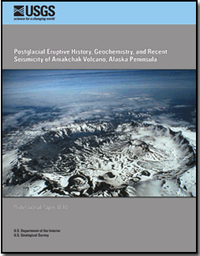Postglacial eruptive history, geochemistry, and recent seismicity of Aniakchak volcano, Alaska Peninsula
Links
- More information: USGS Index Page
- Document: Report (41 MB pdf)
- Appendixes:
- Download citation as: RIS | Dublin Core
Abstract
Aniakchak is a Pleistocene to Holocene composite volcano of the Alaska–Aleutian arc that suffered at least one caldera-forming eruption in postglacial time and last erupted in 1931. The oldest recognized postglacial eruption, Aniakchak I, produced andesite ignimbrite ca. 9,500–7,500 14C yr B.P. Subsequently, a vent northeast of the summit issued dacite–rhyodacite magma ca. 7,000 14C yr B.P. mainly as the Black Nose Pumice falls. The ca. 3,430 14C yr B.P. Aniakchak II eruption produced rhyodacite plinian fall followed by rhyodacite and andesite ignimbrite extending ≥50 km to the Bering Sea and Pacific coasts and resulted in collapse of the 10-km-diameter caldera.
Postcaldera vents are mainly on the caldera ring-fracture system. The earliest extruded small dacite domes into a deep caldera lake and a lava flow on the northwest flank. Three basaltic andesite–andesite tuff cones were constructed on the eastern caldera floor after catastrophic draining of the lake by ~200 m. Dacite–andesite magmas issued from Vent Mountain and Half Cone starting as early as ~1,000 years ago. Plinian eruption at Half Cone ~400 14C yr B.P. yielded widespread dacite Pink and overlying andesite Brown Pumice fall deposits. Strombolian eruption of basaltic andesite built Blocky Cone after Half Cone and most Vent Mountain activity. The most recent eruption, in 1931, yielded dacite–rhyodacite tephra followed by relatively voluminous andesite tephra and ended with minor basaltic andesite.
Current indications of an active magmatic system include high 3He/4He of CO2-rich gas at intracaldera Surprise Lake, InSAR pattern of caldera floor subsidence, and episodic seismicity. The majority of earthquakes are long-period (LP) events. Epicenters for 135 (2009–2012; ML ≤2.1) define a bow-tie pattern elongated parallel to plate convergence. Hypocenters identify events14–28 km below sea level (bsl), few events 7–14 km bsl beneath the caldera, and events <10 km bsl concentrated under Vent Mountain. Recent seismicity is consistent with long-lived mush in the quiet zone, from which magma escapes to be stored ephemerally to within ~2.5 km bsl.
Future volcanic activity of Aniakchak could include hydromagmatic explosions, possibly followed by effusion or strombolian eruption of basaltic andesite to Plinian eruption of dacite. Another voluminous eruption, such as Aniakchak II, is considered unlikely in the near future.
Study Area
| Publication type | Report |
|---|---|
| Publication Subtype | USGS Numbered Series |
| Title | Postglacial eruptive history, geochemistry, and recent seismicity of Aniakchak volcano, Alaska Peninsula |
| Series title | Professional Paper |
| Series number | 1810 |
| DOI | 10.3133/pp1810 |
| Year Published | 2014 |
| Language | English |
| Publisher | U.S. Geological Survey |
| Publisher location | Reston, VA |
| Contributing office(s) | Volcano Hazards Program, Volcano Science Center |
| Description | Report: v, 74 p.; 2 Appendixes |
| Country | United States |
| State | Alaska |
| Other Geospatial | Aniakchak Volcano |
| Online Only (Y/N) | N |
| Additional Online Files (Y/N) | N |


